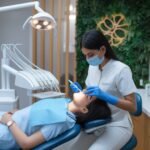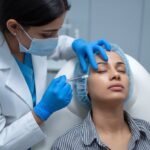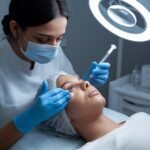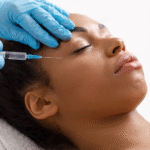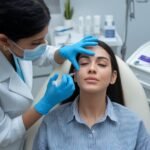How to Get Botox Injection for Forehead Wrinkles Safely
- Home
- Anti-aging
- botox for forehead wrinkles
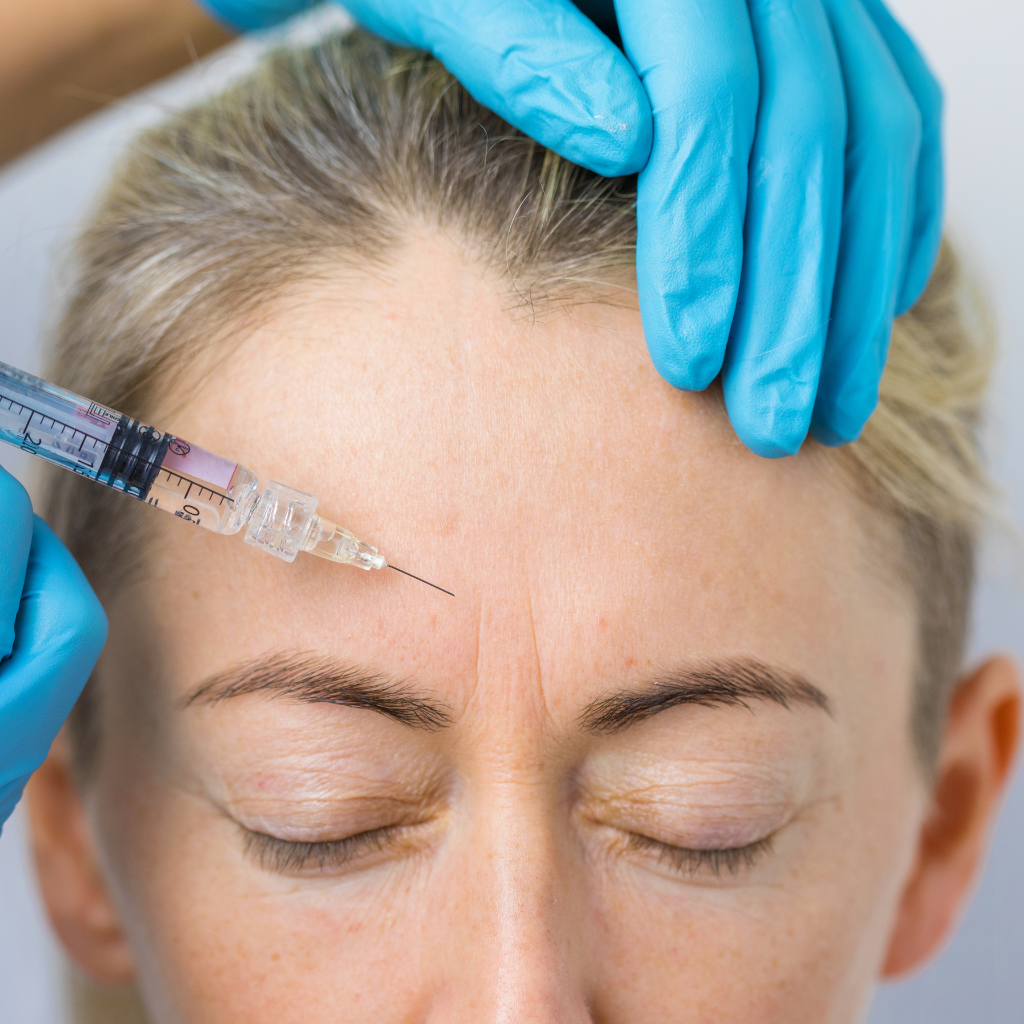
To safely receive Botox injections for forehead wrinkles, consult with a qualified practitioner to discuss medical history, aesthetic goals, and personalized treatment plans. During administration, fine needles strategically target the frontalis muscle, minimizing discomfort. Pre-treatment protocols include avoiding blood thinners, and post-injection care involves abstaining from strenuous activity. Regular treatments every three to four months enhance results, complemented by lifestyle adjustments for long-term wrinkle management. Discover further insights by exploring our detailed guide on Botox injection treatment.
Key Takeaways
- Consult a qualified practitioner to assess forehead muscle suitability and discuss aesthetic goals for a personalized treatment plan.
- Avoid blood-thinning medications pre-treatment to minimize potential side effects and enhance safety.
- Ensure the procedure is conducted in a sterile environment by a professional using a fine-gauge needle for precise Botox delivery.
- Follow post-treatment care instructions, like avoiding strenuous exercise, to maximize Botox results and minimize risks.
- Maintain your results by scheduling follow-up treatments every three to four months and assess individual responses with ongoing practitioner guidance.
What is Botox and How Does it Work for Forehead Wrinkles?
Botox, a purified form of botulinum toxin, is a neurotoxic protein that temporarily blocks the release of acetylcholine at neuromuscular junctions, resulting in muscle relaxation and smoothing of forehead lines.
In cosmetic treatments, its efficacy lies in its ability to diminish dynamic wrinkles caused by repetitive muscle contractions, which are responsible for wrinkles in the first place, such as those on the forehead.
For individuals seeking effective interventions for forehead wrinkles, understanding the role of muscle activity in wrinkle formation is essential to appreciating how Botox can offer temporary amelioration.
How Smooths Botox for Forehead Lines
Revealing the mechanics behind Botox’s efficacy for smoothing forehead lines, this neurotoxin, derived from Clostridium botulinum, operates by temporarily paralyzing targeted facial muscles.
Botox for forehead lines specifically addresses dynamic wrinkles—those formed by repetitive facial expressions. Upon botox injection, the botulinum toxin disrupts acetylcholine release at neuromuscular junctions, inhibiting muscle contraction.
Consequently, the botox treatment smooths the forehead’s surface by reducing movement, thereby diminishing the appearance of wrinkles. This cosmetic treatment has been extensively validated as safe and effective through numerous clinical studies.
Prior to receiving treatment, individuals are advised to consult a qualified professional to assess suitability and discuss potential outcomes. The objective remains to achieve a natural, rejuvenated appearance while maintaining facial expressiveness post-injection.
The Role of Botulinum Toxin in Cosmetic Treatments
Delving into the domain of cosmetic treatments, botulinum toxin emerges as a pivotal agent in the mitigation of forehead wrinkles.
As a highly purified neuromodulator, botulinum toxin, commercially known as Botox, is strategically injected into targeted muscles to address dynamic wrinkles. These wrinkles, primarily caused by repetitive facial movements, are effectively diminished through precise Botox injections.
The mechanism involves temporary inhibition of acetylcholine release at neuromuscular junctions, consequently relaxing muscle contractions responsible for wrinkle formation. Clinicians meticulously determine the appropriate units of Botox to achieve ideal aesthetic outcomes while ensuring safety.
This treatment has gained substantial empirical support for its efficacy in smoothing botox forehead lines, positioning botulinum toxin as a cornerstone in non-invasive cosmetic interventions.
Causes of Forehead Wrinkles and How to Treat Forehead Wrinkles Effectively
Forehead wrinkles, often a result of intrinsic ageing processes and repetitive facial expressions, present a common concern addressed by cosmetic treatments.
The primary causes forehead wrinkles in the first place include the natural breakdown of collagen and elastin, combined with habitual contraction of forehead muscles. As these wrinkles form, they can evolve into deep wrinkles over time.
To effectively treat forehead wrinkles, Botox is a neuromodulator that plays a pivotal role. By inhibiting acetylcholine release at neuromuscular junctions, Botox injections for the forehead temporarily paralyze targeted muscles.
This action reduces muscle activity, thereby lessening the appearance of wrinkles and lines. Evidence supports Botox’s efficacy in smoothing dynamic wrinkles, making it a preferred intervention for those seeking to treat forehead wrinkles effectively.
How to Prepare for a Botox Treatment for Forehead Wrinkles
Preparation for a Botox treatment targeting forehead wrinkles necessitates a thorough consultation where patients can expect a detailed discussion of their aesthetic goals and medical history.
During this appointment, the practitioner will determine the appropriate number of units required for best results, guided by the depth and distribution of the forehead lines.
Pre-treatment recommendations, such as avoiding blood-thinning medications, are critical to minimize potential side effects and enhance the efficacy of the procedure.
What to Expect During Your Consultation
A thorough consultation is an essential precursor to any Botox treatment for forehead wrinkles, ensuring both safety and efficacy.
During a Botox consultation, a licensed practitioner will assess the muscles in your forehead to determine whether Botox is right for you. They will discuss the benefits of Botox, such as smoothing forehead lines, alongside potential risks and side effects.
This evaluation helps formulate a personalized treatment plan, specifying appropriate injection sites and the number of Botox units required. The consultation allows patients to ask questions and express any concerns and express concerns, ensuring informed decisions.
Understanding the anatomy and functionality of the forehead muscles is critical, as it directly influences the outcome of the Botox procedure. This all-encompassing approach maximizes treatment success.
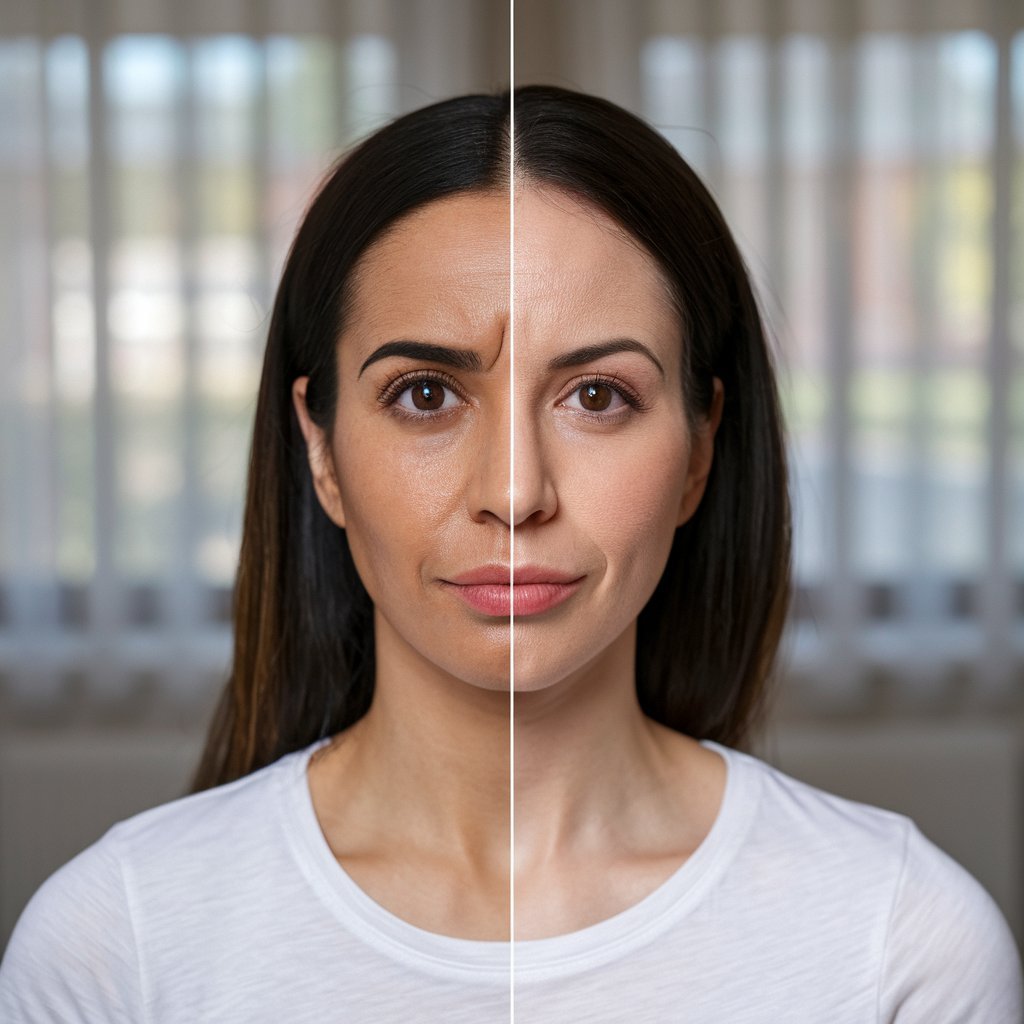
Determining the Right Number of Units for Forehead Lines
Determining the ideal number of Botox units for forehead lines involves a precise evaluation of individual muscle dynamics and wrinkle severity. Clinicians assess deep forehead wrinkles and frown lines to tailor the treatment for forehead lines effectively. The number of units required varies based on the anatomical structure and desired botox results. Injecting botox demands an evidence-based approach to guarantee optimal outcomes when patients get botox for forehead wrinkles.
Wrinkle Severity | Suggested Units | Expected Outcome |
Mild | 10-15 | Subtle Smoothing |
Moderate | 16-25 | Noticeable Improvement |
Severe | 26-35 | Significant Reduction |
The table above illustrates the correlation between wrinkle severity and the number of units, emphasizing the importance of a customized botox treatment plan. Effective botox administration hinges on precise dosing strategies.
Get Pre-Treatment Tips for Optimal Results
Numerous factors contribute to achieving ideal results when preparing for a Botox treatment targeting forehead wrinkles.
Prior to getting Botox treatment, individuals should abstain from alcohol, anti-inflammatory medications, and blood-thinning supplements to minimize bruising risks.
Consultation with a board-certified practitioner is vital, as they assess the appropriate dosage and provide safe Botox techniques.
Those considering Botox should disclose their full medical history, including any allergies or neurological disorders, as these factors may influence the effects of Botox.
Understanding the pre-treatment protocol is essential for best results. Botox injections may cause mild discomfort so that ice packs can be applied preemptively.
Patients should avoid strenuous exercise and lying down immediately after forehead Botox treatments to enhance the results of Botox on your forehead.
How is Botox Administered on Your Forehead?
The administration of Botox for forehead wrinkles involves a precise multi-step procedure that guarantees ideal results with minimal discomfort.
Injection sites are strategically selected based on the individual’s muscle activity and wrinkle patterns, typically focusing on the glabellar lines and horizontal forehead lines.
While the procedure is generally well-tolerated, patients with botox may experience mild discomfort akin to a small pinch, supported by clinical evidence indicating a low incidence of significant pain.
Steps Involved in the Injection Process
Before the administration of Botox on the forehead, a thorough assessment of the patient’s facial anatomy and muscle movement is essential to confirm effective and safe results.
Understanding the nuances of Botox is paramount in confirming its efficacy as a treatment for forehead wrinkles. When receiving Botox, the injector must consider the dynamic musculature that contributes to these lines. Botox is a safe, provided they are performed by a trained and experienced practitioner, and botox works by temporarily relaxing targeted muscles.
- Preparation: Cleanse the forehead to minimize infection risks.
- Injection Technique: Utilize a fine-gauge needle for precision in delivering the botulinum toxin.
- Post-Procedure Care: Patients should avoid lying down or applying pressure immediately after getting Botox injections.
This careful approach confirms Botox can help in the patient’s Botox journey effectively.
The Injection Sites for Treating Wrinkles on Your Forehead?
The administration of botox on the forehead requires accurate identification of injection sites to target dynamic wrinkles effectively. Forehead lines may appear as horizontal forehead lines, primarily caused by repeated muscle contractions.
Injection sites are typically located strategically across the forehead to relax the frontalis muscle responsible for these lines. Botox treatments aim to diminish both superficial and deep forehead wrinkles.
Botox is generally injected in small, controlled doses at multiple points to guarantee even distribution and ideal results. Accurate placement is essential, as incorrect injections may lead to uneven relaxation or impair facial expressions.
Clinicians follow evidence-based protocols to maximize efficacy while minimizing risks associated with Botox on the forehead.
Pain and Discomfort: What to Expect
Patients undergoing Botox administration for forehead wrinkles can anticipate a minimal level of pain and discomfort during the procedure. The injection involves a fine needle penetrating the superficial layers of the skin to target dynamic wrinkles.
Botox treatments are designed to relax the muscle activity responsible for forehead wrinkles, thereby safely diminishing the appearance of fine lines. Evidence supports that patients experience mild sensations which are temporary and manageable.
Key points regarding the experience include:
- Pain perception: Generally mild, often compared to a pinprick.
- Discomfort duration: Brief, with sensations subsiding quickly post-injection.
- Management strategies: Topical anaesthetics or ice may be applied to enhance comfort.
Understanding these aspects allows individuals to prepare effectively for the procedure, ensuring a smoother experience.
What are the Benefits and Effects of Botox for Forehead Wrinkles?
Botox injections for forehead wrinkles offer both immediate and long-term aesthetic improvements by temporarily paralyzing the underlying muscles, thereby reducing the prominence of fine lines and deep wrinkles.
Clinical studies indicate that regular treatments can lead to sustained wrinkle reduction due to decreased muscle activity over time.
Additionally, Botox effectively improves the overall skin texture by smoothing out the surface, providing a rejuvenated and more youthful appearance.
Long-Term Benefits of Botox on the Forehead
The longevity of aesthetic enhancement through botulinum toxin type A injections, particularly in the forehead region, is a demonstration of its enduring efficacy in mitigating dynamic rhytides.
Botox is a versatile treatment, providing myriad benefits of botox for forehead by preventing dynamic wrinkles from forming and reducing static wrinkles over time. Consequently, individuals experience fewer wrinkles and enjoy prolonged aesthetic results as Botox lasts longer with consistent use.
The strategic application of Botox can preemptively address muscle contractions that cause dynamic wrinkles, enabling patients to look and feel your best.
- Prevention of new wrinkle formation: Regular treatments deter the onset of new lines.
- Prolonged wrinkle reduction: Sustained use enhances long-term wrinkle management.
- Versatile treatment applications: Effective for both dynamic and static wrinkles.
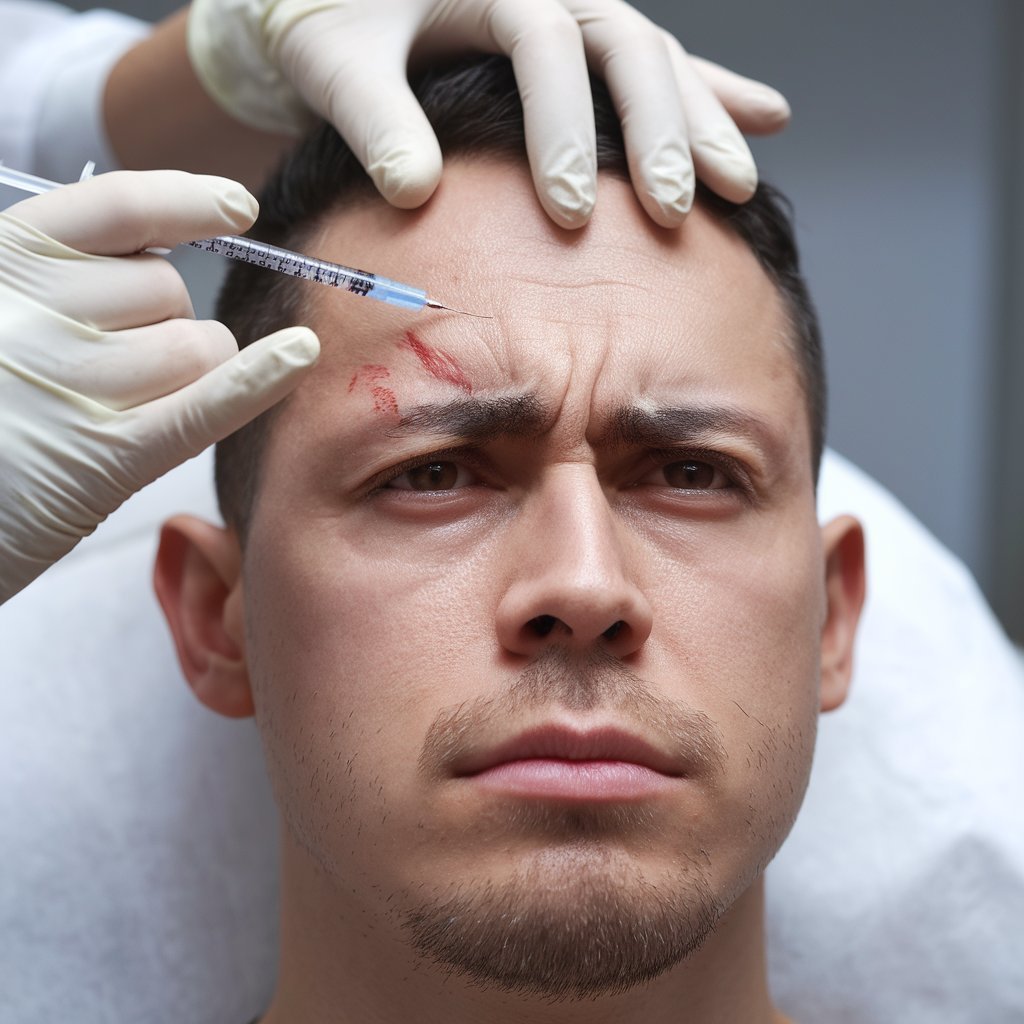
Understanding the Effects of Botox on Fine Lines
Although the pursuit of aesthetic enhancement is common, understanding the precise effects of botulinum toxin type A on fine lines requires a nuanced approach. Botox has become a pivotal tool in dermatology, particularly on the forehead, to address fine lines and wrinkles. Its efficacy lies in its ability to paralyze muscles, reducing wrinkles caused by muscle contractions temporarily. This results in a smoother, wrinkle-free forehead, enhancing the appearance of forehead wrinkles. Similarly, Under-Eye Botox is used to target fine lines around the eyes, though its application requires precision due to the delicate nature of the area.
Emotion | Before Botox | After Botox |
Anxiety | High | Low |
Confidence | Low | High |
Satisfaction | Low | High |
Botox treatments are generally considered effective for superficial lines, although botox can cause temporary side effects. Its application requires precision to achieve desired outcomes without compromising natural expression.
How Botox Improves the Appearance of Deep Wrinkles and Fine Lines
Harnessing the potential of botulinum toxin type A, dermatologists effectively minimize the appearance of deep wrinkles alongside fine lines on the forehead.
Botox treatments work by temporarily paralyzing the underlying muscles responsible for these lines. The injection targets severe forehead lines, smoothing the skin and offering a rejuvenated appearance.
Clinical evidence suggests that appropriately dosed units of Botox can considerably reduce both fine lines and deep wrinkles.
Key benefits include:
- Reduction in deep wrinkles: Targeted injections smooth out prominent lines, enhancing facial aesthetics.
- Improvement of fine lines: Botox provides a subtle lift, refining the overall skin texture.
- Non-invasive procedure: As a minimally invasive treatment, botox offers a safe alternative to surgical options for managing forehead wrinkles.
Strategically administered units guarantee ideal results with minimal side effects.
How to Maintain Results After Botox Injections for Forehead Wrinkles?
To maintain the efficacy of Botox injections for forehead wrinkles, it is vital to implement strategies that prolong the neuromodulator’s effects, such as adhering to recommended skincare routines and avoiding excessive sun exposure.
Regular follow-up treatments, typically advised every three to four months, are essential in sustaining ideal results and preventing the re-emergence of dynamic wrinkles.
Additionally, adopting lifestyle modifications, including adequate hydration and stress management, can synergistically enhance the longevity of Botox outcomes.
Tips for Prolonging the Effects of Botox on Your Forehead
Maximizing the longevity of Botox effects on forehead wrinkles involves a strategic approach that integrates both lifestyle modifications and skincare regimens.
To guarantee the prolonged effects of botox treatments, individuals should consider the following evidence-based tips:
- Minimize Sun Exposure: UV radiation accelerates wrinkle formation; therefore, employing broad-spectrum sunscreen protects against pesky forehead lines.
- Adopt Skincare Regimens: Utilizing topical products containing antioxidants and peptides can enhance skin elasticity and prolong the effects of fewer units of Botox injected.
- Healthy Lifestyle Choices: Maintaining hydration and a balanced diet rich in omega-3 fatty acids supports skin health without Botox, consequently helping to get rid of wrinkles.
These measures help optimize the efficacy of Botox, maintaining smoother forehead lines and reducing the necessity for frequent treatments.
Follow-Up Treatments and Their Importance
Regular follow-up treatments are critical in sustaining the efficacy of Botox injections for forehead wrinkles. Clinical evidence suggests that timely botox treatments help maintain the neuromodulatory effects on the targeted muscles, thereby prolonging the smooth appearance of horizontal forehead lines.
Patients who consistently engage in follow-up treatments often may require fewer units of Botox over time, as the muscles causing wrinkles become conditioned to relaxation. This approach not only optimizes results, but Botox also enhances the safety profile of the procedure.
For deep wrinkles, adhering to a follow-up schedule guarantees that the botulinum toxin maintains its efficiency in smoothing out persistent lines. By getting botox safely and systematically, individuals can achieve sustained aesthetic outcomes, effectively mitigating the recurrence of dynamic forehead wrinkles.
Lifestyle Changes to Enhance Botox Results
In addition to regular follow-up treatments, modifying lifestyle habits can greatly influence the longevity of Botox results for forehead wrinkles. Engaging in certain lifestyle changes may enhance Botox results, allowing individuals to maintain a smooth horizontal forehead and prevent deep lines from reappearing prematurely.
Evidence suggests that these modifications can lead to fewer units required in subsequent sessions:
- Hydration and Nutrition: Proper water consumption and nutritious eating contribute to healthy, elastic skin, optimizing the effects of Botox on the forehead.
- Sun Protection: Utilizing sunscreen can prevent UV damage that exacerbates forehead wrinkles, preserving the effects after Botox.
- Stress Management: Practices such as meditation or yoga may reduce facial tension, minimize the recurrence of deep lines, and improve longevity after Botox treatments.
Implementing these strategies can notably bolster the efficacy of Botox.
Conclusion
In summary, Botox injections for forehead wrinkles are a well-established cosmetic procedure that effectively reduces the appearance of dynamic lines. By temporarily inhibiting the muscle contractions responsible for wrinkle formation, Botox smooths the skin surface, offering a rejuvenated appearance. Proper preparation and administration by a qualified professional are essential to maximize safety and efficacy. To sustain ideal results, patients should adhere to recommended follow-up treatments and maintain a healthy lifestyle, thereby prolonging the anti-ageing effects of the treatment.

Highly skilled cosmetologist at Tune Clinical Aesthetics, specializing in advanced skin and hair treatments.

